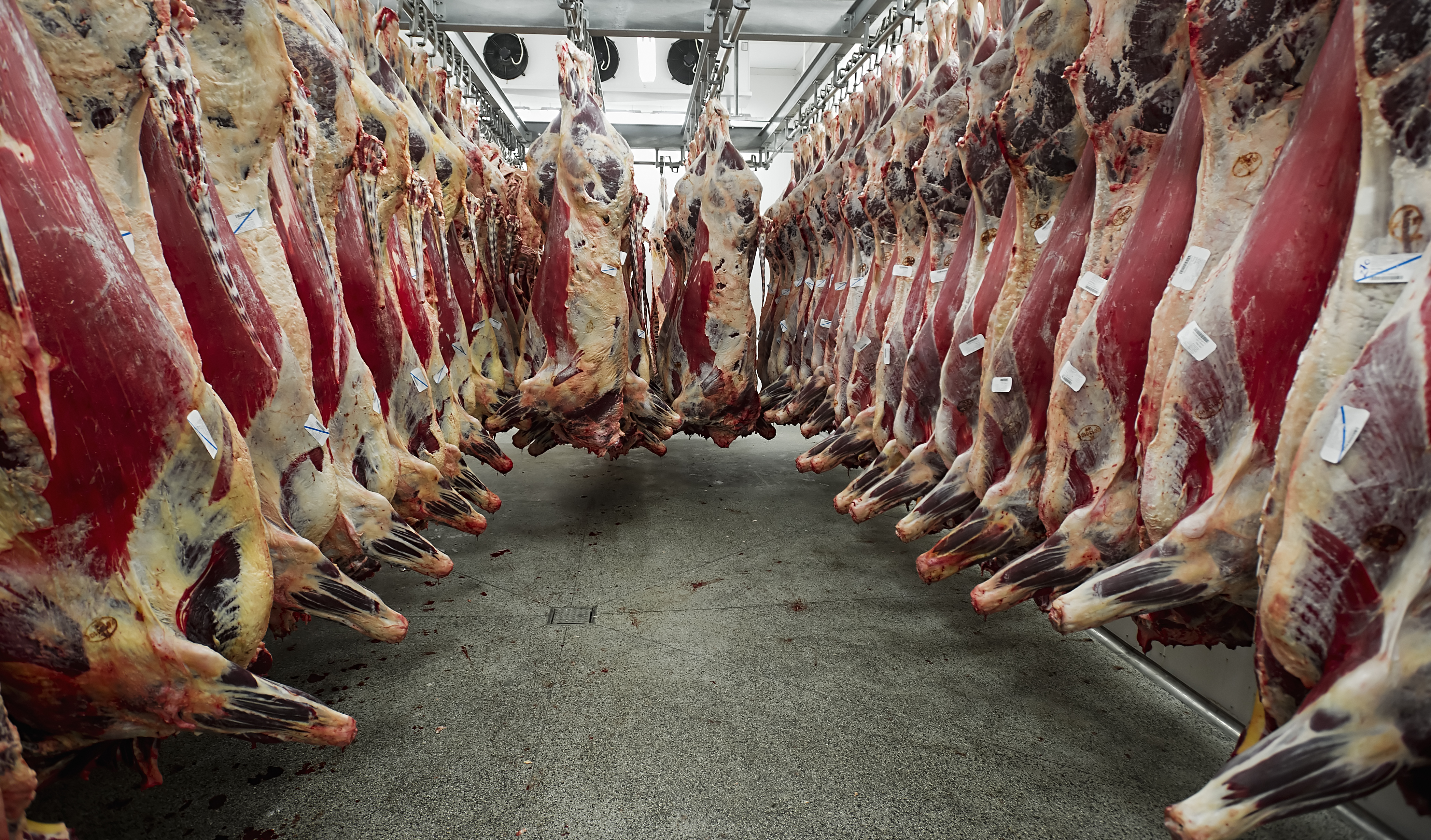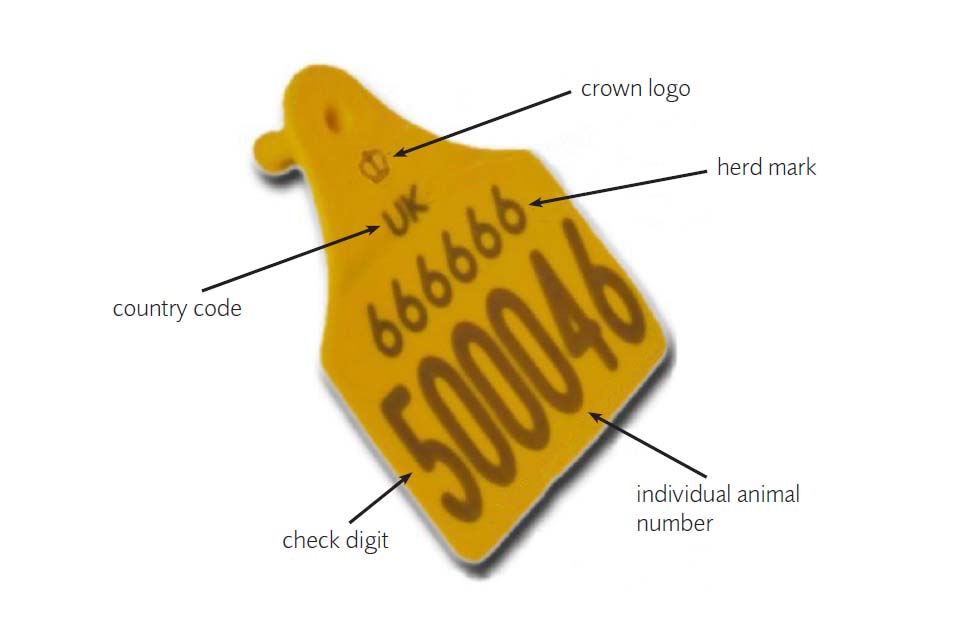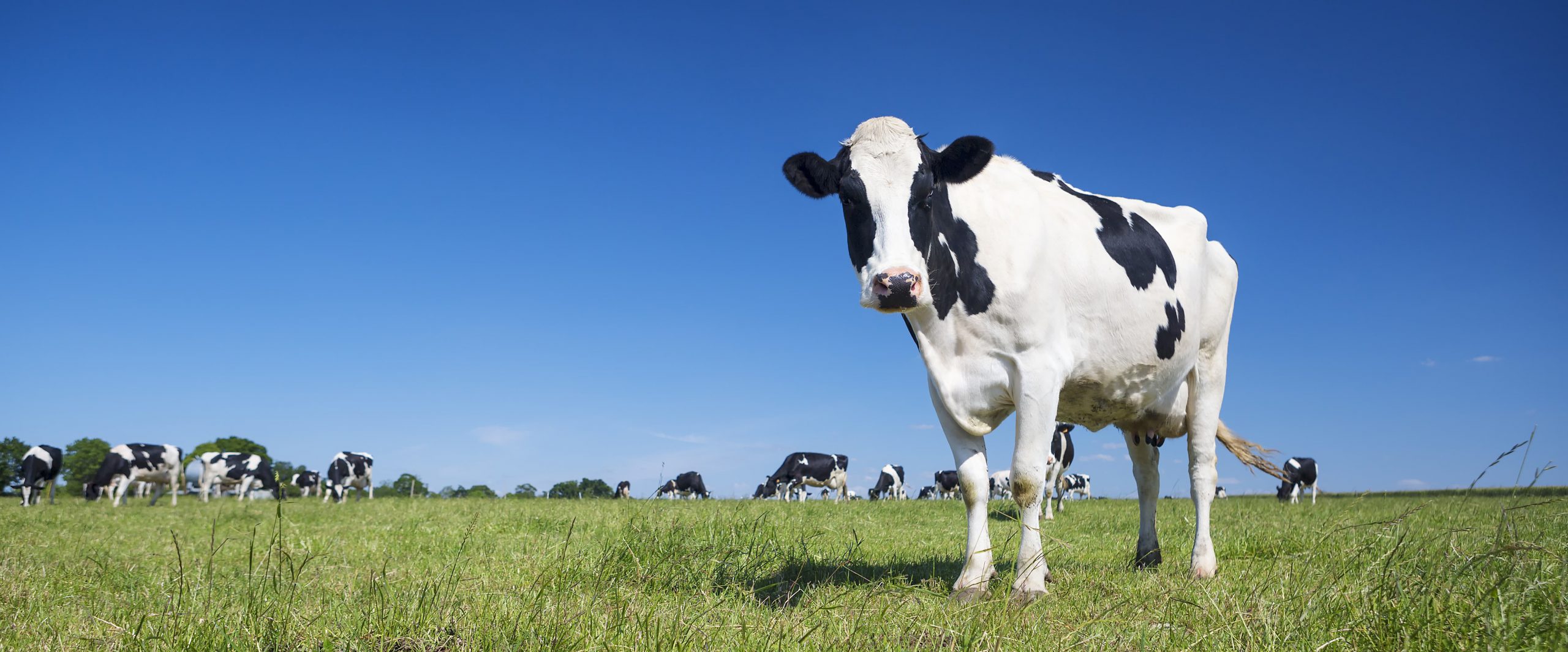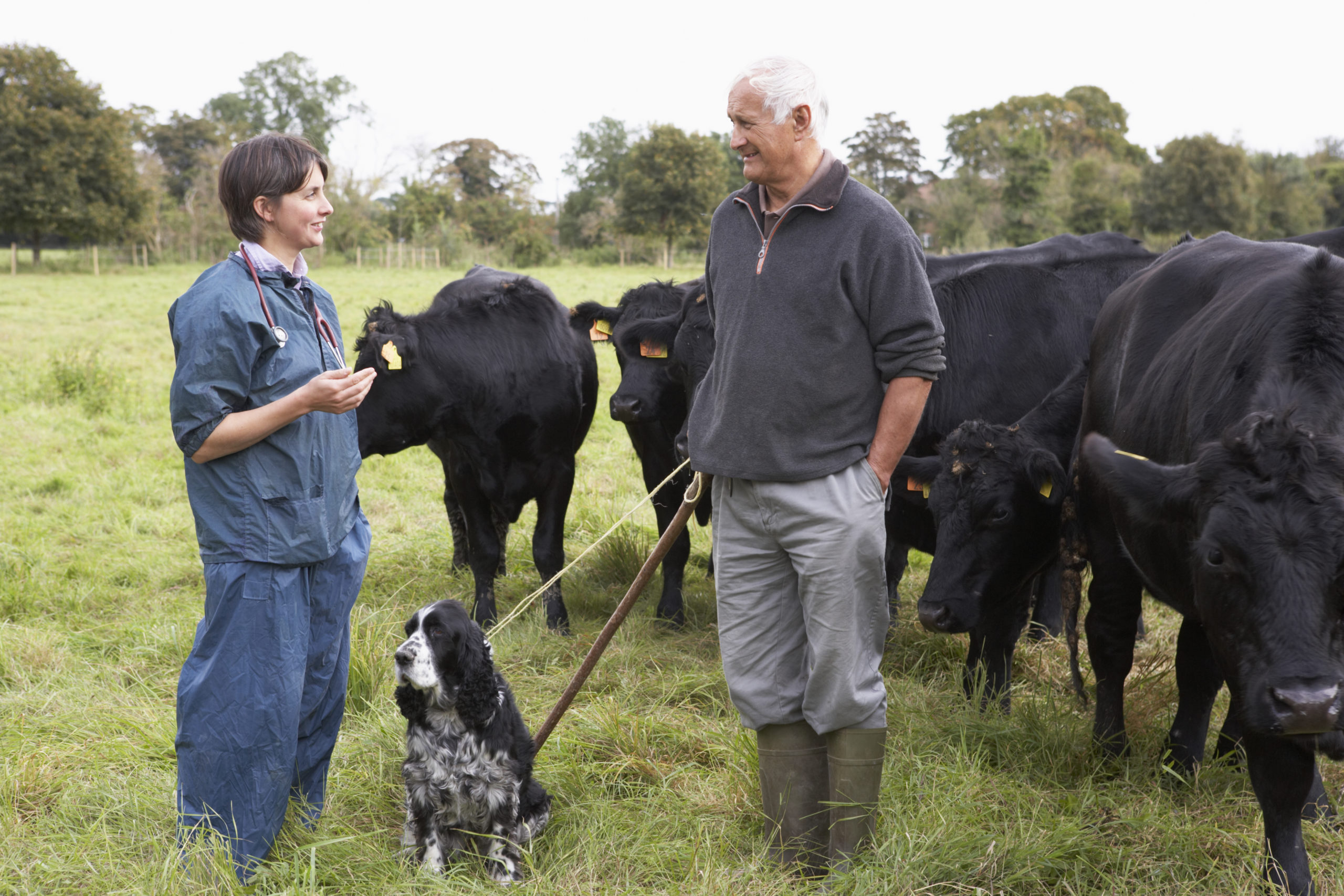This TB cattle control enhancement was introduced by Defra in November 2017 following a public consultation.
The main test used in Great Britain for detecting TB in cattle is the single intradermal comparative cervical tuberculin test (SICCT), more commonly known as the tuberculin skin test. The skin test in cattle relies on detecting and measuring the immune response of the animal to tuberculin, a protein produced by Mycobacterium bovis, the bacterium that causes TB in cattle. The skin test is comparative as the animal’s immune reaction to injections of both bovine and avian (bird) tuberculin is measured and compared. Cattle infected with M. bovis tend to show a greater response to bovine tuberculin than avian tuberculin. Depending on the degree of reaction to the skin test, the animal is classified as negative positive or inconclusive.
Negative result.
Reactor or positive result.
The animal shows a reaction to bovine tuberculin greater than the avian, but not big enough to be classified as a reactor.
IRs are placed under movement restrictions and must be isolated until they are re-tested. The soonest an IR can be re-tested is 60 days after the injection date of the previous test. If the IR tests clear at the re-test, it is known as a ‘resolved IR’. If the IR fails the re-test (i.e. it has a positive result or an inconclusive result for a second time), the animal is compulsorily slaughtered and movement restrictions are placed on the whole herd if that has not already happened. In severe TB breakdowns, IRs may be compulsorily slaughtered at the discretion of APHA as direct contacts (DCs), without a re-test, and with compensation paid.
The TB risk posed by resolved IR animals
Scientific studies looking at resolved IRs in the Republic of Ireland1,2 where bovine TB is widespread, have demonstrated that such animals have significantly higher odds of becoming reactors at a subsequent test in the same or another herd. The studies concluded that:
- Resolved IRs that moved out of the herd within six months of passing their re-test were 12 times more likely to be positive at the next test or slaughter compared to all animals in the national herd1.
- Between 11.8% and 21.4% of IRs slaughtered prior to re-test showed visible lesions suspicious of TB at post mortem meat inspection, compared with less than 0.3% of non-IR animals1.
- During the study period, the time to detect TB in resolved IRs was 78% shorter, on average, compared to clear-testing cattle2.
These studies provided evidence for the introduction of a new policy for resolved IRs in the Republic of Ireland in 2012. After reviewing the evidence, Defra introduced a similar policy in England in 2017.
Further research has been carried out exploring the risk posed by resolved IRs in England and Wales3,4, which adds to the evidence above. This latest research found that the odds of a resolved IR becoming a subsequent reactor during the study period were seven and nine times greater than for negative testing animals in the HRA and Edge Area of England, respectively3. The increased risk of becoming a reactor supports the policy to restrict resolved IRs to the herd in which they were found for life.
At herd level, the time interval before a new TB breakdown in IR-only herds (those with IRs only and no reactors) in England and Wales was around half that of herds with a negative whole herd test. The hazard of a subsequent TB breakdown was 2.7 times greater for IR-only herds compared with clear herds in year one, after accounting for the influence of accepted risk factors of TB4. Analyses of cattle herds in England in 2019 showed that in the High Risk Area (HRA), 40% of IR-only herds went on to have a TB incident (with lesion and/or culture positive animals) within the following 15 months (33% in the Edge Area)5.

Why not just compulsorily slaughter all IRs?
Compulsory slaughter of all IRs would increase the probability of rapidly removing all TB-infected animals in herds. However it would be at a disproportionate cost, as increased numbers of TB-free cattle would be slaughtered resulting in additional herds being unnecessarily placed under movement restrictions.
This is why the government adopted the alternative approach of restricting resolved IRs to the holding in which they were found for the rest of their life. This contains the potential disease risk to that holding and reduces the risk of spread of disease. Cattle keepers have the option to slaughter resolved IRs, effectively removing the risk from the herd.
Restriction of resolved IRs for life
All IRs in the HRA and Edge Area (and in TB breakdown herds in the LRA) that have a negative result on re-testing remain restricted for the rest of their life to the holding in which they were found. The only permitted off movements for such animals are to a slaughterhouse or Approved Finishing Unit (AFU). The cattle can move directly or via an approved slaughter gathering or TB dedicated sale (orange market). To release resolved IRs in officially TB free (OTF) herds from life-long restrictions, the option of private interferon-gamma blood testing (paid for by the animal owner) is available to cattle keepers, subject to securing prior approval from APHA.
Resolved IRs in TB restricted herds undergoing government funded mandatory gamma testing will automatically be included in any whole herd testing as long as they are over six months of age, therefore private gamma testing is not necessary in these cases.
Ideally, the blood sample should be collected on or after the tuberculin injection date (day 1) of the clear IR skin retest. An IFN-y blood test undertaken before the first day of the IR retest can still qualify to lift the lifelong restrictions from the resolved IR, if it is undertaken after the animal was disclosed as an IR. For unresolved IRs, an IR skin retest with a negative result is always required before an animal (or herd) TB movement restrictions can be lifted
If a resolved IR tests negative to the gamma test, movement restrictions on the animal are lifted and it can move freely, unless whole herd movement restrictions apply. Cattle keepers wishing to take up private gamma testing should contact their private vet who needs to secure permission from APHA to carry out the test. It is important to note that if the test result is positive the animal is compulsorily slaughtered (with compensation paid), movement restrictions are placed on the whole herd (if not already in place) and the standard TB breakdown procedures followed.

Identification of resolved IRs
It is the cattle keeper’s responsibility to ensure resolved IRs are restricted for life to the holding in which they were found. Although not a mandatory requirement, Defra recommends that such animals are physically identified to prevent accidental movement off the holding.
This could be achieved by using a management tag or freeze branding, and/or marking the animal’s passport.

Restriction of resolved IRs
Resolved IRs are automatically restricted following their clear re-test, and keepers receive a restriction notice in the post. Resolved IRs are restricted for life to the holding in which they were found, and this holding must have a permanent County Parish Holding (CPH) number. If a resolved IR is residing at temporary grazing when it re-tests clear, it is restricted to the permanent CPH associated with the temporary grazing. Once the resolved IR moves back to the permanent CPH, it is restricted to that CPH and cannot move back to a temporary CPH.
Permitted routes to slaughter for resolved IRs
The table below summarises the permitted routes to slaughter for resolved IRs from officially TB free (OTF) and TB-restricted herds. Resolved IRs moving under a licence issued by APHA must meet all conditions stated on the licence, including pre-movement TB testing requirements. Licences for movements of resolved IRs from TB-restricted holdings are issued subject to a satisfactory risk assessment. For general information about applying for a licence to move TB-restricted cattle, read the guidance on licensing.
| Permitted route to slaughter | Licence | |
|---|---|---|
| Resolved IRs in OTF herds | Direct to a licensed slaughterhouse in England or Wales | General licence available on GOV.UK |
| Approved TB-dedicated sale (orange market) in England | ||
| Approved Finishing Unit (AFU) in England or Wales, or Approved Finishing Unit (Enhanced) with grazing (AFUE) in England | ||
| Approved TB-dedicated sale (orange market) in Wales | Specific TB208 licence | |
| Resolved IRs in TB-restricted herds | Direct to a licensed slaughterhouse in England or Wales | Specific TB24 licence or general TB24c licence usually included in the reactor pack issued at the start of the TB breakdown |
| AFU in England or Wales, or AFUE in England | Specific TB16 licence | |
| Approved TB slaughter gathering in England or Wales | Specific TB24b licence | |
| Approved TB-dedicated sale (orange market) in England or Wales | Specific TB16b licence | |
| Another TB-restricted holding in England or Wales | Specific TB16 licence |
Q&A
All IRs in the HRA and Edge Area (and in TB breakdown herds in the LRA) that have a negative result on re-testing remain restricted for the rest of their life to the holding in which they were found. The only permitted off movements for such animals are to slaughter, either directly or via an Approved Finishing Unit.
Resolved IRs have a significantly higher likelihood of becoming reactors than clear tested animals, and as such present an increased risk of spreading TB. Restricting resolved IRs for life to the holding in which they were found prevents transfer of this risk to other herds.
Slaughtering all IRs would be disproportionately costly. Increased numbers of TB-free cattle would be slaughtered resulting in additional herds being unnecessarily placed under movement restrictions. Accepting that the risk can never be completely eliminated, the policy aims to reduce the risk to an acceptable level with the resources available to the government.
No, not necessarily. Keepers can send an IR to slaughter privately, before it is re-tested, under licence from APHA. Keepers wishing to privately slaughter an IR must contact APHA to discuss the implications and obtain a licence to move the animal to slaughter.
It is the keeper’s responsibility to ensure resolved IRs are restricted for life to the holding in which they were found. If a keeper intends to retain resolved IRs in their herd it is advisable, but not mandatory, to physically identify them to prevent their accidental movement off the holding. This can be achieved by using a management tag or freeze brand and/or marking the animal’s passport. It is also advisable to keep a record of any resolved IRs in the herd register.
A restriction notice is issued by APHA explaining the conditions of the restrictions and the keeper’s obligations.
Potentially, yes. Cattle keepers can commission Interferon-gamma blood testing of resolved IRs at their own cost. The keeper must first seek permission from APHA through their private vet.
Ideally, the blood sample should be collected on or after the injection date (day 1) of the clear IR re-test. An IFN-y blood test undertaken before the first day of the IR retest can still qualify to lift the lifelong restrictions from the resolved IR, if it is undertaken after the animal was disclosed as an IR. For unresolved IRs, an IR skin retest with a negative result is always required before an animal (or herd) TB movement restrictions can be lifted.
If the resolved IR tests negative to the gamma test, the animal is free to move off the holding, unless it is subject to any other whole herd movement restrictions. If the animal tests positive, it is compulsorily slaughtered (with compensation paid), movement restrictions are applied to the whole herd (if not already in force), and standard TB breakdown procedures followed.
Animals less than six months of age are excluded from gamma testing as their immune systems are still developing and this can interfere with the test, leading to false positive results. If a resolved IR is too young for a gamma test, the keeper may apply to APHA to defer the test until the animal becomes old enough. The keeper or their private vet must contact APHA to discuss the situation and all cases are assessed on an individual basis.
A resolved IR in a TB-restricted herd undergoing government funded mandatory gamma testing will automatically be included in any whole herd testing as long as it is over six months of age. If the resolved IR tests negative to the gamma test then the restrictions on the animal are lifted, though it would continue to be subject to whole herd movement restrictions. If the resolved IR tests positive to the gamma test it is compulsorily slaughtered with compensation paid, just like any other reactor.
Yes. Resolved IRs are permitted to move to slaughter directly or via an approved slaughter gathering. If your herd is officially TB free, you don’t need to apply to APHA for a specific licence. The general licence is available to view and download from GOV.UK. Although a copy of the general licence doesn’t need to accompany the cattle, you should familiarise yourself with the conditions before moving the animals to slaughter. Resolved IRs in TB breakdown herds are sent to slaughter using the licences issued to you by APHA, for example the general licence to slaughter TB24c.
Yes. Resolved IRs can be moved to an Approved Finishing Unit (AFU) either directly or via an approved TB dedicated sale (orange market). If your herd is officially TB free, this move can take place using the general licence available on GOV.UK. Although a copy of the general licence doesn’t need to accompany the cattle, you should familiarise yourself with the conditions before moving the animals. Resolved IRs in TB breakdown herds can be sent to an AFU or approved TB dedicated sale subject to particular conditions. You will need to apply to APHA for a specific licence.
Temporary CPH (tCPH)
Resolved IRs found at a tCPH are restricted for life to the permanent CPH associated with the tCPH. The resolved IR is only permitted to move back to the permanent CPH associated with the tCPH, or to slaughter either directly or via an AFU. Once back at the permanent CPH, the animal is restricted for life to that CPH.
Temporary Land Association (TLA)
If a resolved IR is found at a TLA it is restricted to the permanent CPH associated with the TLA. Subsequent movements of the resolved IR to the TLA are permitted, as by definition the land falls within 10 miles of the permanent CPH. For more information on livestock movements, tCPHs and TLAs, see the Defra guidance.
If a resolved IR is found whilst at common grazing it is restricted for life to the keeper’s home holding which must have a permanent CPH number. The resolved IR is not permitted to move to common grazing again because of the increased risk it potentially presents to other herds that use the common land.
No. Resolved IRs are restricted to the holding in which they were found for the rest of their life and cannot move off to agricultural shows.
Yes. Resolved IRs can move off the holding for veterinary treatment under a licence issued by APHA. After treatment the animal must return directly to the home holding or to slaughter.
APHA carries out percentage checks of resolved IRs to ensure that they remain restricted for life. Non-compliances are referred to the relevant Local Authority for investigation and any enforcement action they deem appropriate.
References
- Clegg, T. A. et al. Shorter-term risk of Mycobacterium bovis in Irish cattle following an inconclusive diagnosis to the single intradermal comparative tuberculin test; Preventive Veterinary Medicine 102(4):255-64
- Clegg, T. A. et al. Longer-term risk of Mycobacterium bovis in Irish cattle following an inconclusive diagnosis to the single intradermal comparative tuberculin test; Preventive Veterinary Medicine 100 (3-4):147-154
- May E, Prosser A, Downs S. H, Brunton L. A. Exploring the risk posed by animals with an inconclusive reaction to the bovine tuberculosis skin test in England and Wales; Veterinary Science 2019, 6(4), 97
- Brunton L. A, Prosser A, Pfeiffer D. U, Downs S. A. Exploring the fate of cattle herds with inconclusive reactors to the tuberculin skin test; Front. Vet. Sci. 2018 (5) 228
- Bovine TB epidemiology and surveillance in Great Britain, 2019, APHA

Useful resources
- Inconclusive reactor factsheet
- Private gamma testing
- Tuberculin skin test
- Defra guidance on livestock movements, temporary CPHs and Temporary Land Associations